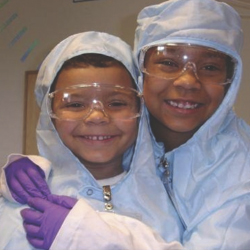No CrossRef data available.
Article contents
How to translate materials science concepts into K–12 student outreach activities
Published online by Cambridge University Press: 27 April 2011
Abstract

As the complexity of global materials science challenges increases, so does the need for materials science and engineering literacy and career recruitment. Many funding agencies are addressing this by including requirements for achieving broader impacts (e.g., National Science Foundation grants, European Commission Framework), and resources have been created from a variety of sources to help. This article addresses the issue of how to translate materials science concepts into K–12 outreach activities, with an emphasis on how to use the human, physical, and information resources available. Researchers may best reach their outreach objectives by distilling content rather than diluting it, connecting on a human level, highlighting the true nature of science, not reinventing the wheel, being a role model, and having fun. Initiatives that support outreach efforts are referenced and include examples from the Materials Research Society.
- Type
- Research Article
- Information
- MRS Bulletin , Volume 36 , Issue 4: Addressing broader impacts through K–12 outreach in materials education , April 2011 , pp. 278 - 283
- Copyright
- Copyright © Materials Research Society 2011




